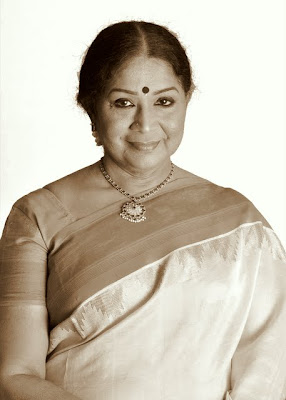 Kerala has always been in the forefront when it comes to classical arts and it is no surprise that the state is home to quite many Padma awardees. This year three artistes from Kerala have been honored with one of the highest civilian award. The Kalaparva celebrates this spirit, featuring a chat with Kalamandalam Kshemavathy Pavithran, adorned with the Padma Shri for her contribution to Mohiniyattam. Here is an excerpt from our conversation.
Kerala has always been in the forefront when it comes to classical arts and it is no surprise that the state is home to quite many Padma awardees. This year three artistes from Kerala have been honored with one of the highest civilian award. The Kalaparva celebrates this spirit, featuring a chat with Kalamandalam Kshemavathy Pavithran, adorned with the Padma Shri for her contribution to Mohiniyattam. Here is an excerpt from our conversation. Kalamandalam, a temple of learning and a place where training knows no bounds, has been your alma mater. What motivated you to join the institution at a young age?
As a young girl, I was fascinated by dance and so learnt a few popular items like Kaliyamardanam, and pieces on songs like “Aamalar Poigayil Aadikalikkunna Omana Thamara Poovae”. This little exposure increased my yearning to dance and I was desperate to take it seriously, which is when I found Shri Kochukuttan Asan. It so happened that somebody from his own family joined under him and he refused to take classes for me. Much to the distress of my family, I went door to door finding a teacher and it is this fire that brought me to Kalamandalam where I enrolled at the age of eleven for a diploma in Mohiniyattam and Bharatanatyam, with a stipend.
How have been your formative years in the Kalamandalam? Any cherished childhood memories? Has the institution changed over time? Any contrasts?
At a time when Mohiniyattam dancers and teachers refused to come out in the open, owing to the bad reputation the dance form got during its degradation, Vallathol Narayana Menon had to search widely to find a Mohiniyattam instructor. That’s how he came across Chinnammu Amma who hailed from Pazhayannur in Thotassery and brought her to Kalamandalam. She taught us a few items that she remembered - a Cholkettu in Chakravaham, Chenchuritty Jatiswaram, a Padam in Churutti and a Telugu Varnam in Yadhukula Khamboji called “Swamy Ninney Nammithir”. These items formed our bible. We evolved with Kalamandalam when teachers like Kalamandalam Satyabhama and Tanjore ARR Bhaskar Rao experimented and brought in the repertoire format with a Cholkettu, followed by Jatiswaram, Varnam, and Padam (like Indalihavalarunnu Manini, Enthaho Vallabha). Chinnammu Amma used to say that Thillana was in the repertoire too. But she couldn’t recollect clearly. Based on her vague rendering of "Dhanee Dhara Dhaaaney Dhaney Dhaney Dhom", we choreographed a Thillana.
The days at Kalamandalam were fully packed with exercises in music from 5.30 AM followed by body exercises and adavus till 12:30 PM. The afternoon sessions would start from 2:30 PM and last till 5:30 PM when items would be taught. After the evening lessons on most days Chinnammu Amma teacher and our group of seven students would go for bath in the nearby river Bharatapuzha. People used to tease us calling “Ali Baba and Forty Thieves”. Later in the evening we had music classes and Kannu Sadhakam (eye exercises after applying ghee as kajal). Our sessions would end by 8:30 PM. Weekends were holidays, which were usually spent in reciting the Bharatanatyam Jatis and Mohiniyattam Adavus.
Yes, Kerala Kalamandalam has changed over time. From a time when there was only a diploma class run under one roof, Kerala Kalamandalam today has become a deemed University with school, plus two, graduate, post graduate and research facilities. Students joining high school study other subjects in addition to their chosen main subject like Mohiniyattam or Kathakali Vesham. Thereby the training time for the main subject is reduced to a great extent unlike during our times. We studied only the main subjects, like Mohiniyattam and Bharatanatyam, in which we underwent intense training. It helped create very good dancers. Of course the other academic degrees which Kalamandalam now offers were not available during our times.
 You have learnt various styles of classical dance. Was it a conscious decision to get more opportunities? Do you think Mohiniattam has had fewer opportunities as compared to the other dance forms?
You have learnt various styles of classical dance. Was it a conscious decision to get more opportunities? Do you think Mohiniattam has had fewer opportunities as compared to the other dance forms? After finishing my course at Kalamandalam in 1963, much through others insistence, I started giving classes, though my aim was to better myself as a dancer. I took advance lessons in Bharatanatyam from Guru Muthuswamy Pillai, Guru Chitra Viswesaran and Guru Adayar K Lakshman in Chennai. For some time, about four months a year, I stayed in Chennai. I started learning Kuchipudi too from Guru Dr Vempatty Chinnasatyam and had my arangetram; I was also part of many of their Kuchipudi dance dramas. These experiences, I believe, have made me improve greatly as an artiste. I saved up the money I got for my concerts in Kerala and used it for my advance lessons in Chennai. More than learning new pieces, it was about understanding and experiencing the entire choreography process and style of my gurus. Chennai was also a place to watch artistes and be a part of the cultural happenings. The city made a huge difference to my artistic pursuit, and I improved both within and outwardly as an artist. I established a dance school “Kerala Kalamandiram” at Thrissur in 1964-1965.
My main focus was on Bharatanatyam and Kuchipudi. Mohiniyattam was limited to one or two items. The trend in Kerala, in those days, was to present different styles of dance in a concert. After one or two Mohiniyattam pieces I would go on to do Bharatanatyam and then Kuchipudi, for two hours. I performed at many prestigious venues in Chennai, and thankfully one never felt that I mixed the three styles.
Yes, when compared to other dance forms Mohiniyattam has fewer opportunities. But I think, it is getting better these days.
A major part of your work revolves around contemporary themes and compositions based on Malayalam poetry. Does it suit the subtle dance form?
Staying within the boundaries of tradition, I wanted to promote Mohiniyattam by incorporating new ideas and experimenting with the existing repertoire. My work on new themes within the repertoire, moving far away from the traditional Vipralambha Shringara based pieces, have always come as breathers. Probably, I was the first one to make strong portrayals in Mohiniyattam, like depicting a male character Kuchela from Kuchela Vritham (taken from “Narayaneeyam” of Sri Melpathoor Narayana Bhattathirippad). Along side traditional themes, I was also interested in working on contemporary poems. I choreographed famous Malayalam poetess Smt Sugatakumari’s “Krishna Nee Enne Ariyilla” and “Rathri Mazha”. “One Day” or “Oru Divasam” is a contemporary piece specially written describing about a day in the nature. I have also choreographed Sri Kumaran Aasan's famous poems like “Chintavishtayaya Seetha” and “Leela” and Sri Kalidasa’s “Megha Doot”. My contributions to the Mohiniyattam repertoire include more than thirty Varnams besides Bhajans, Ashtapadis, Invocatory pieces and Thillanas. My husband used to play ghazals for me, almost everyday and a piece “Jab Raath Ki Tanhai…” has been a dedication to him.
I do not fear in presenting themes which are close to my heart. As long as we follow the basic grammar of the dance form, there is no harm in experimenting, making it relevant in today’s world and taking the dance form forward.
Kerala has for years nourished high quality talent. Artistes from the state have always remained low key by choice. It is only their creations and work that has spoken louder. Your opinion.
Yes, I have seen in the past that artistes from Kerala have achieved a lot, but remained low key. I am not sure how far it is true today. I have never endorsed publicity for my works and productions, however big it may be.
Any cherished experiences from your professional life that you would like share with our readers?
It was heartening to see a French appreciate my performance of “Kuchela Vritham” taken from “Narayaneeyam” in France. He happened to be a Sanskrit scholar and even recited the many slokas of Narayaneeyam much to my astonishment.
Finally, how do you feel on being bestowed with the Padma Shri? Is it an added responsibility?
Whenever I get an award, I always feel that it is an added responsility.

